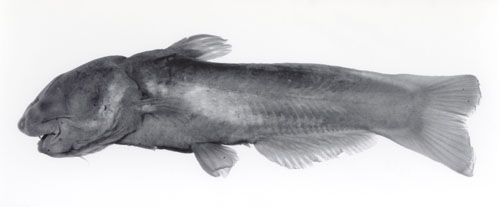
Reproduced from Vari, Ferraris and de Pinna (2005).
Denticetopsis epa Vari, Ferraris & de Pinna, 2005
Identification: Denticetopsis epa can be differentiated from D. royeroi and D. sauli by the combination of the lack of elongate, symphyseal teeth on the dentary, the lateral line extending posteriorly on the body beyond the abdomen at least onto the caudal peduncle, the presence of dentition on the vomer, a dorsal fin with 5 or 6 segmented rays and a first ray which is spinous basally, a symmetrical, shallowly-forked caudal fin, and the possession of horizontally-elongate, stellate, dark chromatophores on the body when the chromatophores are expanded. Denticetopsis epa differs from D. macilenta. in the relative length of the pelvic fin (tip of the pelvic fin reaching to the posterior margin of the vent versus falling just short of the anterior margin of the vent, respectively), in the relative position of the eye (anterior limit of eye located at, or posterior of, the vertical through the anterior limit of the maxillary-barbel groove versus middle of the eye located at the vertical through the anterior limit of the maxillary-barbel groove, respectively), and to a degree in the total number of vertebrae (38 to 40 versus 40 or 41). Denticetopsis epa differs from D. praecox in the relative length of the pelvic fin (reaching to the posterior margin of the vent versus falling just short of the anterior margin of the vent, respectively) and in the number of premaxillary tooth rows (three rows of teeth on premaxilla in all but smallest examined specimens versus two rows of teeth, respectively). Denticetopsis epa differs from D. iwokrama in the number of total anal-fin rays (25 to 27 versus 29, respectively) and in the number of caudal (26 to 28 versus 32, respectively), preanal (14 or 15 versus 17, respectively), and total vertebrae (38 to 40 versus 43, respectively). Denticetopsis epa differs from D. seducta in the relative position of the origin of the anal fin (approximately at the vertical through the middle of TL versus distinctly anterior of that point, respectively) and in the relative depth of the caudal peduncle relative to the length of the caudal peduncle (depth/length 1.15-1.3 versus 1.33-1.5, respectively). Maximum size: 47 mm SL.
Range: Denticetopsis epa is known from several localities in the lower portions of the Rio Tocantins basin.
Information from Vari, R. P., C. J. Ferraris Jr. & M. C. C. de Pinna. 2005. The Neotropical whale catfishes (Siluriformes: Cetopsidae: Cetopsinae), a revisionary study. Neotropical Ichthyology 3:127-238.
